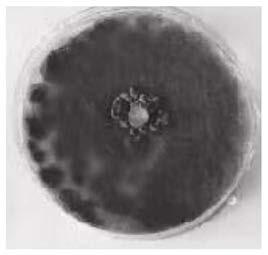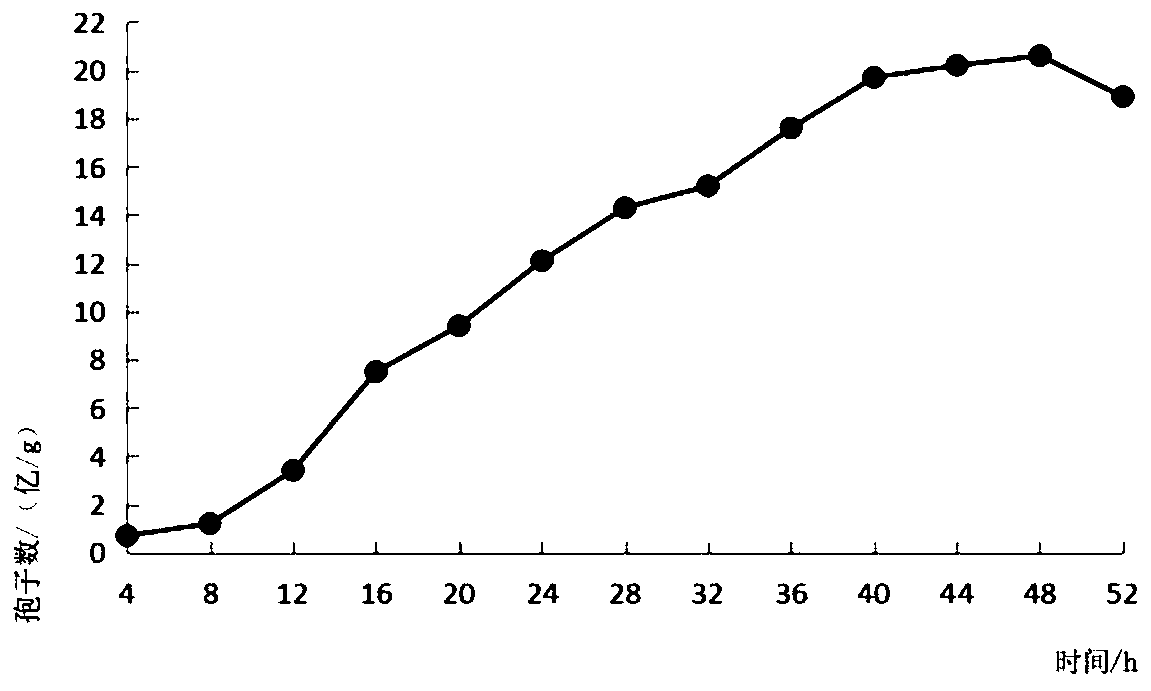High-temperature-resistant Aspergillus fumigatus 23# and application thereof
A technology of Aspergillus fumigatus and high temperature resistance, applied in the field of microorganisms, can solve the problems of environmental pollution, high cost, complicated degradation conditions, etc., and achieve the effects of reducing product cost, accelerating decomposition, and improving germination rate
- Summary
- Abstract
- Description
- Claims
- Application Information
AI Technical Summary
Problems solved by technology
Method used
Image
Examples
Embodiment 1
[0039] A kind of Aspergillus fumigatus bacterial strain 23#, its screening process is as follows:
[0040] 1) Soil collection: In this experiment, the rhizosphere soil of cucumbers affected by the disease in Cangzhou, Hebei Province was collected, and the collected soil samples were stored at 4°C for future use in screening soil fungi.
[0041] 2) Separation and purification of soil fungi: ① Take 5g of soil and add it to 1% physiological saline to form a ratio of 1:102 , 1:10 3 , 1:10 4 , 1:10 5 and 1:10 6 After fully shaking the soil dilution solution, draw 100 μL of the above-mentioned soil dilution solutions of different dilutions and spread them on the PDA solid medium containing ampicillin, and then place the PDA solid medium at 28°C for 2 to 3 days. . ② After culturing, select typical fungal colonies and continue pure culture on PDA solid medium.
[0042] 3) Strain identification: ① Extract fungal DNA by CTAB method. Genomic DNA of the strain TJ was extracted using...
Embodiment 2
[0050] The cultivation method of aspergillus fumigatus Aspergillus fumigatus 23#, its step is as follows:
[0051] Aspergillus fumigatus 23# spore powder was inoculated on the enzyme-producing medium at 1% (weight ratio), cultured at 37° C., and the culture ended after 48 hours. Use a hemocytometer to measure the number of spores, and the number of spores is greater than 20×10 8 CFU / g. The number of spores of the strain increased rapidly after 12 hours of culture, and the number of spores was as high as 3×10 8 CFU / g, slowly increasing within 16h-40h, tending to be flat at 40-48h, until reaching the maximum at 48h, the number of spores is greater than 20×10 8 CFU / g, the concentration of spore number decreased after 48h. Compared with the general Aspergillus fumigatus strain, the sporulation speed was significantly accelerated (1×10 8 CFU / g). (Spore count curve see figure 2 ).
Embodiment 3
[0053] Aspergillus fumigatus 23# and other Aspergillus fumigatus strains 30# isolated from our laboratory were inoculated on the differential enzyme-producing cellulose-decomposing medium, and cultured for 3 days. Be careful not to contaminate it and save it for later use. After the colony grows well, open the cover and spread it out on the table, use a pipette gun to draw 5mL0.1% Congo red solution onto each plate, slowly rotate until the Congo red solution evenly covers the surface of the plate, and let it stand for 30 minutes for staining. Pour off the excess liquid; then use a pipette gun to draw 3mL1mol / L NaCl eluent onto each plate, rotate slowly until the surface of the plate is evenly covered, let stand for decolorization for 1h, and elute for 20min, then add 3ml of 5% sodium acetate solution to fix After 10 min of treatment, excess liquid was poured off. Observe the comparison of the size of the transparent circle and the strain (see the results of the transparent ci...
PUM
| Property | Measurement | Unit |
|---|---|---|
| temperature | aaaaa | aaaaa |
Abstract
Description
Claims
Application Information
 Login to View More
Login to View More - R&D
- Intellectual Property
- Life Sciences
- Materials
- Tech Scout
- Unparalleled Data Quality
- Higher Quality Content
- 60% Fewer Hallucinations
Browse by: Latest US Patents, China's latest patents, Technical Efficacy Thesaurus, Application Domain, Technology Topic, Popular Technical Reports.
© 2025 PatSnap. All rights reserved.Legal|Privacy policy|Modern Slavery Act Transparency Statement|Sitemap|About US| Contact US: help@patsnap.com



